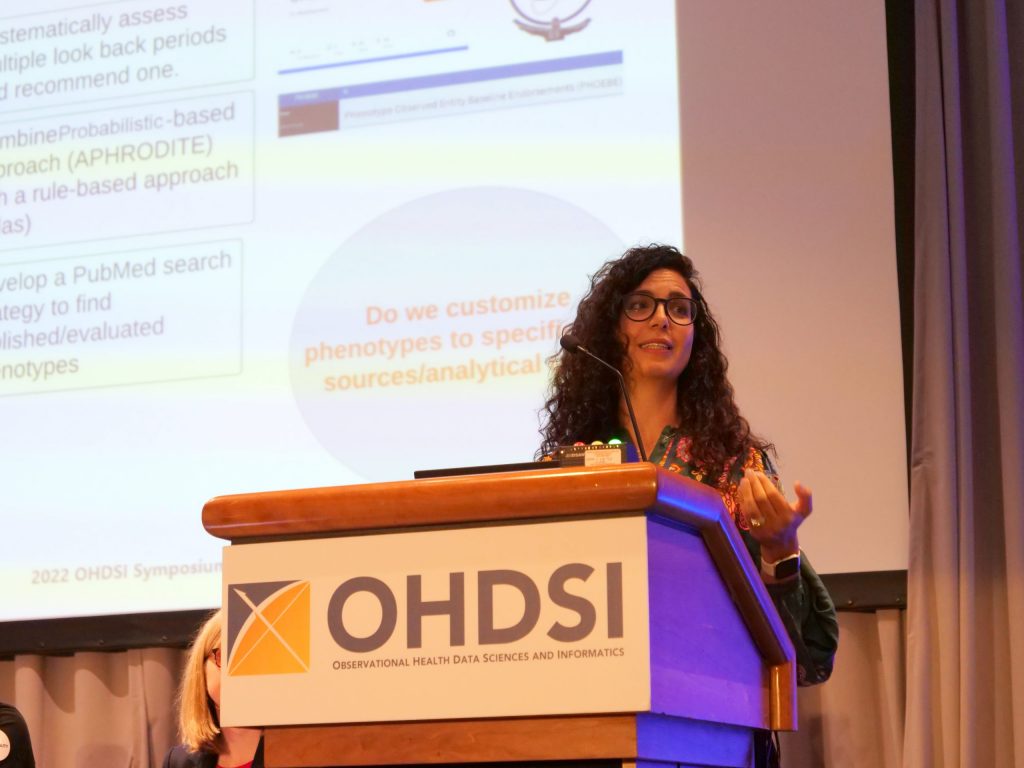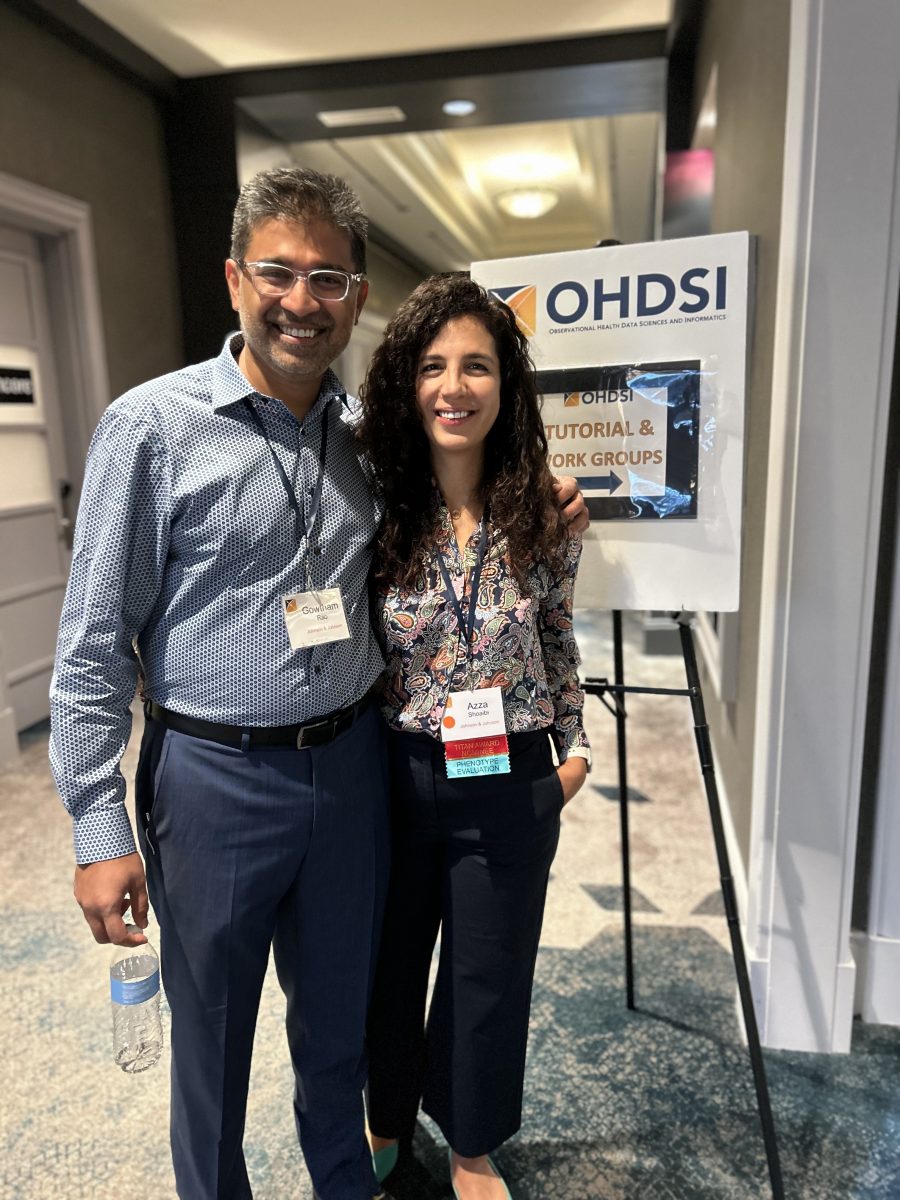- Who We Are
- Updates & News
- Standards
- Software Tools
- Network Studies
- Community Forums
- Education
- New To OHDSI?
- Community Calls
- Past Events
- 2024 India Symposium
- 2024 Europe Symposium
- 2024 Thailand Tutorial
- 2024 Japan Tutorial
- 2024 DevCon
- 2024 Phenotype Phebruary
- 2023 Global Symposium
- 2023 APAC Symposium
- 2023 Europe Symposium
- 2023 SOS Challenge
- 2023 DevCon
- 2023 Phenotype Phebruary
- 2022 Global Symposium
- 2021 Global Symposium
- 2020 Global Symposium
- ALL Past OHDSI Events
- Workgroups
- 2024 ‘Our Journey’ Annual Report
- Current OHDSI Events
- Support & Sponsorship
- CBER Best Seminars
- 2024 Global Symposium
- 2024 APAC Symposium
- Github
- YouTube
- Newsletters
Collaborator Spotlight: Azza Shoaibi
Previous Collaborator Spotlights
Azza Shoaibi has been collaborating with the OHDSI community for several years, and has recently taken up new leadership opportunities around phenotyping.
An Associate Director with Janssen Research and Development, Inc., Shoaibi first found OHDSI while she was a postdoctorate fellow in bioinformatics at the Medical University of South Carolina. Since then she has led or participated in several network studies, helped lead the first two Phenotype Phebruaries, and presented during the lightning talks at the 2022 OHDSI Global Symposium.
In the latest collaborator spotlight, Azza discusses her journey to observational health data work, why the science of phenotyping is both challenging and exciting, why she serves on the OHDSI Symposium Scientific Review Committee, and plenty more!

Can you discuss your background and what made you interested in health data science?
I have a degree in pharmacy (PharmD), and soon after I graduated from pharmacy school I went back to Palestine (my home country) and realized that I prefer research much more than clinical work, and that I wanted to do something in public health. I went for a master’s degree in public health and I got a Fulbright scholarship to do my PhD in epidemiology here in the United States. During my PhD program, I got introduced to observational health data as an intern at the VA. I was lucky enough to be able to do my dissertation using the VA observational data to develop a diagnostic model to detect prostate cancer at early stage. I then went on to do a postdoctorate fellowship in bioinformatics at the Medical University of South Carolina (MUSC), where I got introduced to OHDSI.
How did you get involved with OHDSI, and what made you believe that this community could be impactful?
The director of my lab at MUSC was very interested in OHDSI. Additionally, Gowtham Rao (who was my fiancé at the time and already working in the field of bioinformatics/pharmacovigilance) was following OMOP/OHDSI work. We both attended the 2015 OHDSI symposium here in the US out of curiosity, as well as to help our institution understand more about the community. What I learned and observed in the one-day symposium and the two days of tutorials that followed convinced me that the community has what it takes to push our young science forward. Patrick Ryan was giving his closing talk that year and my whole perception about what can be done, and the opportunity in front of us to improve people’s health, changed forever.
You led an early COVID study assessing the effectiveness/safety of famotidine as a treatment. While people can read the study, what are a couple things you learned about running such a time-sensitive study using OHDSI tools/practices?
Completing that study in a span of 3 weeks, I experienced what blows every scientist’s mind. Once the clinical question was clear, OHDSI resources/tools/best practices enabled me to rapidly generate evidence that was critically needed in a structured, standardized, transparent and reliable manner that no other way can possibly do. I learned that a lot of the methodological choices that many times researchers dwell on do not matter. At the same time, many other things that we don’t pay attention to can affect a study result. But most importantly, we can and should assess empirically all the choices we make, and OHDSI tools are designed to do exactly that.

Azza Shoaibi (right) and husband Gowtham Rao led Phenotype Phebruary over the last two years, and Azza also helps put together the Global Symposium Collaborator Showcase as a member of the Scientific Review Committee.
You have guided the community through a pair of Phenotype Phebruary activities. People may understand what phenotypes are, but what don’t many understand about either the challenges or opportunities around them?
Yes, the science of phenotyping is very exciting because it’s immature, so it’s very challenging and at the same time there is huge opportunity for improvement. When you phenotype using observational data, you are trying to capture individuals with a particular event of interest, and you don’t and will never know the final truth. You are using the evidence you have in the data to make that judgement! It’s like detective work! Traditionally we use a very small piece of the data we have to make these decisions, like a diagnosis code, but we have the entire patient journey in our hand to make that judgment! This is where the opportunity presents itself. The challenge is figuring out what is only noise, and what is not!
Was there a highlight or two from the most recent Phenotype Phebruary that you can share with the community?
This is tough, every week of the four weeks we had was a highlight! My happiest moment was every time people with diverse backgrounds got together to develop or evaluate phenotypes. Every time, almost every member in the team learned something new about the phenotype! When it comes to phenotyping, the interaction between the data experts and the clinical experts using the data we expose in OHDSI tools (using a diverse network of data sources and not only one) is not only exciting and useful but really eye-opening!
You are a member of the OHDSI Scientific Review Committee. What is the value of the OHDSI collaborator showcase, and how much do you enjoy helping to review and organize it?
The collaborator showcase is inspiring for all members of the community, new and old. Personally, these presentations give me ideas of how OHDSI tools can be used to generate reliable evidence (applications) and also what innovations (methodological and technological) are possible and feasible. Helping in the review committee is very rewarding and a lot of fun! It is a great way to be part of OHDSI.
What are some of your hobbies, and what is one interesting thing that most community members might not know about you?
People say I am a very good cook! I can bike for many many miles before feeling tired 😊, and nothing makes me happier than a sunny day and blue skies!
